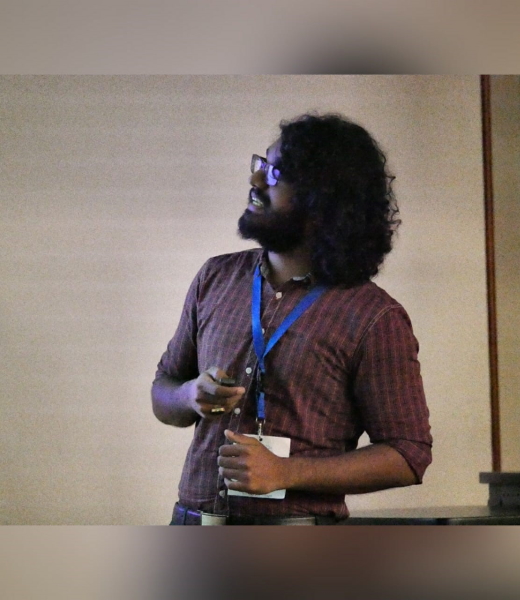Nicholas Mohammed

Contact Information
Location
Education
- PhD Zoology Candidate – The University of the West Indies (2019 – Present)
- MSc. (Dist.) Biodiversity Conservation and Development in the Caribbean – The University of the West Indies (2015-2018)
- BSc. (Hons.) Biology, Minors: Biotechnology, Environmental and Natural Resource Management - The University of the West Indies
Project Detail
Research Interests
- Spatial Modelling
- Radio Tracking
Work Experience
- Laboratory Technician
- Department of Preclinical Sciences, Biochemistry Unit, The University of the West Indies (2017- Present)
- Statistician
- Freelance (2018-Present)
Awards
Second Best Student Presentation at the Latin America and Caribbean Congress for Conservation Biology Conference (2018)
Academic Presentations
- PhD. Proposal Seminar. The University of the West Indies, St Augustine (2019). Title: “Bites and Flights, A study of The Common Vampire Bat (Desmodus rotundus) In Trinidad.”
- Latin America and Caribbean Congress for Conservation Biology Conference (2018). Title: “Stats and Bats: Estimating the population size of Desmodus rotundus in Trinidad using a statistical model.”
- 2nd Annual FST Research Symposium, The University of the West Indies, St. Augustine (2018). Title: “Stats and Bats: Estimating the population size of Desmodus rotundus in Trinidad using a statistical model.”
- MSc. Biodiversity Conservation and Development in the Caribbean Seminar (2017). Title: “Stats and Bats: Estimating the population size of Desmodus rotundus in Trinidad using a statistical model.”
Publications
- International Journal of Biochemistry Research and Review| 2018
Title: Causes and Concerns of Diabetic Subjects with Lower Limb Amputation(s) in Trinidad
Shivananda Nayak, Rondon Ramlal, Amit Ramrattan, Vandana Sookdeo, Nicholas Mohammed and Akash S. Nayak
Abstract: This study comprised 35 patients who were subject to LEAs of differing degrees and these patients were selected via a random stratified methodology. After obtaining informed consent, questionnaires were used to attain subjective and objective data as it pertains to the cause and effects of lower limb amputations. Statistical analysis was done using SPSS to test for distribution and correlations. A number of factors were considered and measured as it pertained to the cause of having an amputation. Our study noted that the major factors like diet, alcohol consumption and infection became the reason for amputation.
- Endocrinology & Diabetes Research| 2018
Title: Determination of Adenosine Deaminase Levels in Patients With and Without Community Acquired Pneumonia - A Trinidadian Study
Shivananda Nayak, Nicholas Mohammed, Terry Gavaskar Ramnanansingh, Akash S Nayak
Abstract: To determine the relationship of adenosine deaminase (ADA) concentration in a population of community acquired pneumonia (CAP) patients and evaluate its potential link to factors such as ethnicity, smoking and hypertension. The study comprised of 58 patients; 29 of which were diagnosed with CAP and whose clinical data were compared to patients without CAP. ADA assays were performed and analyzed on all patients. Community-acquired pneumonia patient samples showed significantly increased ADA levels and can be further associated with ethnicity and smoking. The data of this supports the use of ADA levels for the diagnosis of CAP and further research in these mechanisms is encouraged with a larger sample size.
- International Journal of Development Research| 2018
Title: Merits and Demerits of Statins, A Cholesterol Lowering Agent - A Review
Shivananda Nayak, Nicholas Mohammed and Katrina Bhagwandeen
Abstract: A number of published journals were examined in order to gather information and insight into the matter. Based on the results it was noted that statins actively reduce cholesterol (LDLc and total cholesterol) and apolipoprotein B levels and prevent the risk of cardiovascular diseases. However, it was also presented that statins can be linked to a number of adverse effects including but not limited to muscle complications, rhabdomyolysis and pancreatitis. At present the number of viable merits as it pertains to statin use as a means of controlling or treating hypercholesterolemia are numerous and includes but is not limited to: increased HDL cholesterol and Apolipoprotein A1, as well as a noteworthy, decreased in total cholesterol. Further research be done in order to expand further upon the uses and possible adverse effects of statins.






